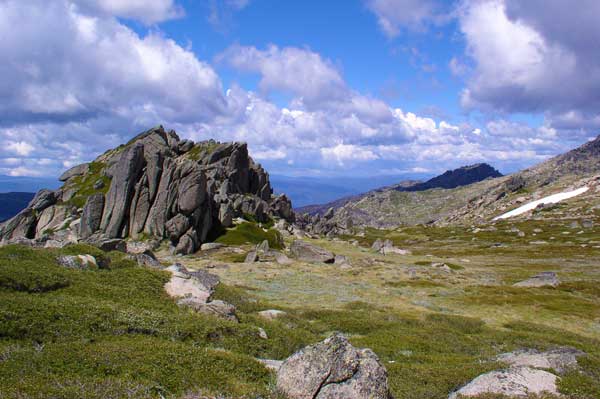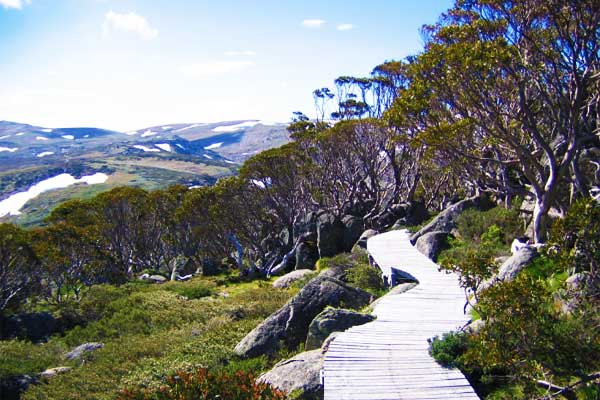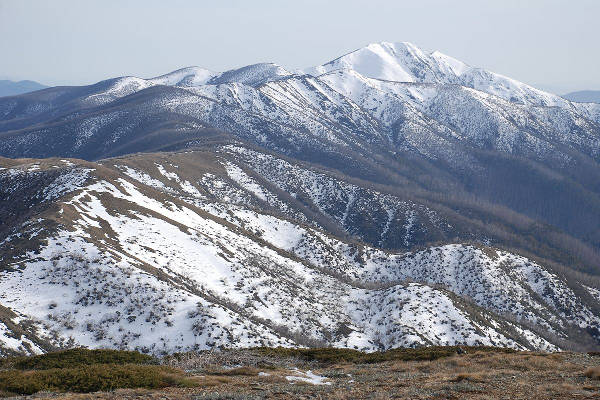The Australian Alps, located in south-eastern Australia, are home to mainland Australia’s only peaks exceeding 2,000m above sea-level.
Its highest peak is Mount Kosciuszko, which stands at 2,228m above sea-level and is located in the subrange, the Snowy Mountains.
The Australian Alps are home to a variety of native plant and animal species which have evolved to survive the harsh mountain climate.
Here, you can experience Australia’s only true alpine climate.
Below is a guide on the Australian Alps, where you can find facts on the range, as well as information on its notable mountains and hikes. See best hikes in Australia, featuring a hike from this region.
Australian Alps
Geology
The beginning of the formation of the Australian Alps occurred with the splitting of the super continent Gondwana. 160 million years ago, Gondwana began to stretch from lines of weakness.
Under the flat plain, the earth’s crust became thinner and weaker, this allowed hot magma from deep below to rise up. The magma heated the crust and added new lighter rocks, this caused the crust to expand upwards to form a plateau nearly 2km high. This plateau was the beginning of the Australian Alps.
By 100 million years ago, the stretching turned to splitting and 80 million years ago, Gondwana’s stretching created the highlands.
It was the weather that would finally shape the mountains. Frost, wind and water carved deep valleys into the plateau, gradually moulding it into the Australian Alps.
Topography
The Australian Alps constitutes the largest section of the Great Dividing Range, it is also home to Australia’s highest mountain.
The landscape of the Australian Alps is characterized by peaked ranges and broad, forested valleys. It is the only true alpine environment in New South Wales.
Climate
The climate of the Australian Alps is dominated by a montane climate, with no dry season and a mild summer.
However, the Australian Alps is also home to a patch of true alpine climate in the southwest of the range, it experiences no dry season and a cool summer.
Above 1,400m above sea-level, snow may persist for 4-6 months of the year and frost can occur throughout the year. The north-eastern tip of the Australian Alps has a temperate climate, with warm summers and no dry season.
The mean annual temperature of the Australian Alps ranges from 3 - 12C, with a minimum average monthly temperature of -7 to -4C and a maximum average monthly temperature of 15.9 - 29.5C.
Wildlife and Plants
The diverse vegetation of the Australian Alps provides habitats for a wide variety of wildlife. There are more than 40 species of native mammals, 200 bird species, 30 reptile species, 15 amphibians, 14 species of native fish as well as many species of invertebrates.
Non-native animals also make the Australian Alps their home; including dogs, cats, pugs, the European rabbit, black rat and red fox which have introduced to the area.
The vegetation in the Australian Alps is similar to vegetation that can be found throughout Australia; including eucalypt forests, open woodlands and herb fields, but the vegetation that exists up in the mountains has evolved to survive in the harsh climate of the Australian Alps.
Mountain Regions In Australian Alps
The Australian Alps are made up of the Snowy Mountains and the Victorian Alps.
Snowy Mountains
The Snowy Mountains are located in New South Wales and the Australian Capital Territory. They are home to the highest mountains in Australia, including Mount Koscuiszko, which is the highest point in mainland Australia, standing at 2228m above sea-level.
Victorian Alps
The Victorian Alps, also known as the high country, are located in Victoria. The reach a maximum elevation of 1986m above sea-level, which is the peak of Mount Bogong. The range is 400km long, 200km wide and has an area of 5,199km squared.
Notable Australian Alps' Peaks
The Australian Alps contains Australia’s only peaks exceeding 2000m above sea-level, all of which are located in the subrange, the Snowy Mountains.
Mount Kosciuszko
Mount Kosciuszko, located in the Snowy Mountains, is the highest mountain in the Australian Alps as well as the highest peak in mainland Australia.
It is 2,228m above sea-level and is situated in Kosciuszko National Park.
The first ascent of this mountain was in 1840.
Mount Townsend

Photo by Ursula
Mount Townsend is the second highest peak in Australia’s mainland.
Like Mount Kosciuszko, Mount Townsend is located in Kosciuszko National Park. The peak stands at 2209m above sea-level.
Its craggy peak arguably makes it more dominant than the slightly higher Mount Kosciuszko, which has a more rounded top.
Mount Twynam
Mount Twynam is located in the Main Range of the Snowy Mountains and is the third highest peak in mainland Australia at a height of 2,195m above sea-level.
It is located approximately 8km north-east of Mount Kosciuszko.
Mount Twynamn is close to the border of New South Wales and Victoria and has a spectacular view over Blue Lake Cirque and the Western Falls.
The mountain is relatively accessible by track yet is rarely visited.
Mount Rams Head

At 2,190m above sea-level, Mount Rams Head is the fourth highest peak on Australia’s mainland.
It is located in the Rams Head Range of the Snowy Mountains an also falls within the Kosciuszko National Park.
The mountain is an all-season tourist attraction.
Rams Head North Mountain
Rams Head North Mountain is the 5th tallest peak in mainland Australia and stands at 2177m above sea-level.
Rams Head North Mountain lies northeast of Mount Rams Head and south of Mount Kosciuszko.
Notable Hikes in the Australian Alps Range
Although the Australian Alps aren’t known for having incredibly high peaks, it still offers a variety of hiking and trekking experiences. Depending on which trail you choose to embark upon, you may be camping, but obviously, one-day hikes won’t require such.
Summer is the best time to hike, as snow can cover the trails in winter if you are trekking at higher elevations. However, summer doesn’t mean perfect weather and thunderstorms and even snow can threaten your hike.
The one-day hikes can easily be done independently, but if you are looking to embark upon the Australian Alps Walking Trail, a guide is highly recommended unless you have a high level of experience and expertise on long-distance treks.
Kosciuszko Walk

Photo by Quoc Viet Truong
The Mt Kosciuszko hike takes you to the summit of mainland Australia’s highest mountain. In summer, the hike begins from the Kosciuszko Express Chairlift at Thredbo and takes you to the summit of Mount Kosciuszko, where you will be treated 360-degree views of the Snowy Mountains.
It is a 14km return walk and should take you around 5 hours to complete.
The landscape includes rocky granite outcrops, wildflowers and glacially carved Lake Cootapatamba. This hike can be done easily independently or with a guide.
Australian Alps Walking Track
This spectacular 655km long trek begins at Walhalla, Victoria and ends in Tharwa in the Australian Capital territory.
The trail winds through a series of national parks and can take up to 8 weeks to complete. This is a fiercely challenging trek and is only suitable for very seasoned explorers or those in guided groups.
You will experience the rugged and remote alpine country as you pass through 3 states and several national parks.
Mt Bogong via the Staircase Spur Trail
Explore Victoria’s High Country with this hike to the summit of the region’s highest mountain, Mount Bogong. This 8km hike will take you 4 hours one way and begins at the Mountain Creek picnic area in the Alpine National Park.
The trail follows a vehicle track to the foot of the Staircase Spur, where the ascent begins. You will walk through a forest of peppermint gums.
Half way up the mountain you will find Bivouac Hut, a great place to rest. From here the trail passes through snow gums and alpine shrub and out onto the summit plain.
This trail is of moderate difficulty and can be done with or without a guide.
Mount Townsend Guided Hike
This 22km guided hike is the perfect choice for outdoor lovers. The hike takes you to the summit of Mount Townsend, which at 2,209m above sea-level is the second highest peak in mainland Australia.
The hike, which will take you around 6 hours is an intermediate/advanced level hike which will require a good level of physical fitness.
You will experience the beauty of the Snowy Mountains, with amazing views overlooking the mountain tops as well as spectacular views of New South Wales.
References: Britannica, Australian National Heritage Service, Wikipedia


